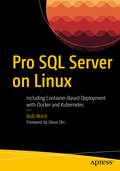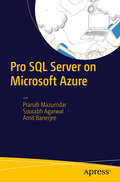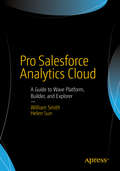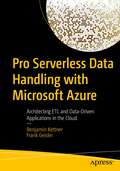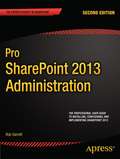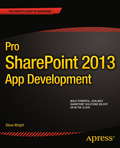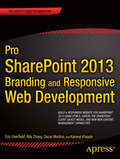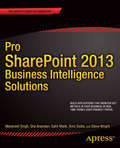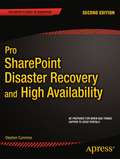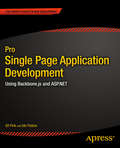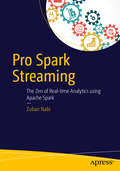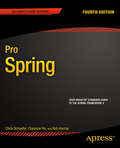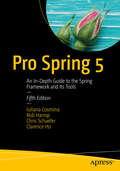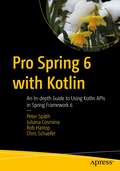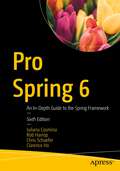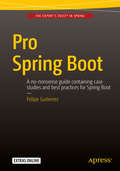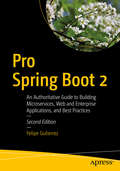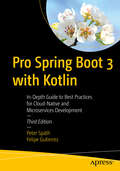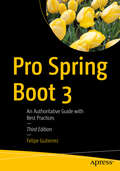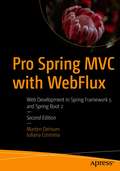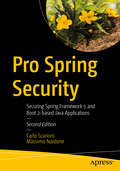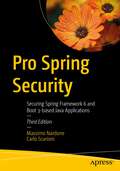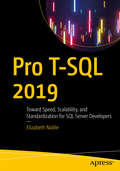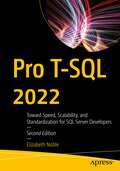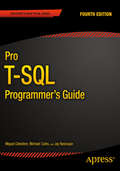- Table View
- List View
Pro SQL Server on Linux: Including Container-Based Deployment with Docker and Kubernetes
by Bob WardGet SQL Server up and running on the Linux operating system and containers. No database professional managing or developing SQL Server on Linux will want to be without this deep and authoritative guide by one of the most respected experts on SQL Server in the industry. Get an inside look at how SQL Server for Linux works through the eyes of an engineer on the team that made it possible.Microsoft SQL Server is one of the leading database platforms in the industry, and SQL Server 2017 offers developers and administrators the ability to run a database management system on Linux, offering proven support for enterprise-level features and without onerous licensing terms. Organizations invested in Microsoft and open source technologies are now able to run a unified database platform across all their operating system investments. Organizations are further able to take full advantage of containerization through popular platforms such as Docker and Kubernetes. Pro SQL Server on Linux walks you through installing and configuring SQL Server on the Linux platform. The author is one of the principal architects of SQL Server for Linux, and brings a corresponding depth of knowledge that no database professional or developer on Linux will want to be without. Throughout this book are internals of how SQL Server on Linux works including an in depth look at the innovative architecture.The book covers day-to-day management and troubleshooting, including diagnostics and monitoring, the use of containers to manage deployments, and the use of self-tuning and the in-memory capabilities. Also covered are performance capabilities, high availability, and disaster recovery along with security and encryption. The book covers the product-specific knowledge to bring SQL Server and its powerful features to life on the Linux platform, including coverage of containerization through Docker and Kubernetes.What You'll LearnLearn about the history and internal of the unique SQL Server on Linux architecture.Install and configure Microsoft’s flagship database product on the Linux platformManage your deployments using container technology through Docker and KubernetesKnow the basics of building databases, the T-SQL language, and developing applications against SQL Server on LinuxUse tools and features to diagnose, manage, and monitor SQL Server on LinuxScale your application by learning the performance capabilities of SQL ServerDeliver high availability and disaster recovery to ensure business continuitySecure your database from attack, and protect sensitive data through encryptionTake advantage of powerful features such as Failover Clusters, Availability Groups, In-Memory Support, and SQL Server’s Self-Tuning EngineLearn how to migrate your database from older releases of SQL Server and other database platforms such as Oracle and PostgreSQLBuild and maintain schemas, and perform management tasks from both GUI and command lineWho This Book Is ForDevelopers and IT professionals who are new to SQL Server and wish to configure it on the Linux operating system. This book is also useful to those familiar with SQL Server on Windows who want to learn the unique aspects of managing SQL Server on the Linux platform and Docker containers. Readers should have a grasp of relational database concepts and be comfortable with the SQL language.
Pro SQL Server on Microsoft Azure
by Amit Banerjee Pranab Mazumdar Sourabh AgarwalLearn the basics of Microsoft Azure and see how SQL Server on Azure VMs (Infrastructure-as-a-Service) and Azure SQL Databases (Platform-as-a-Service) work. This concise book shows you how to deploy, operate, and maintain your data using any one or a combination of these offerings along with your on-premise environment. Pro SQL Server on Microsoft Azure is a quintessential book for any IT professional who is planning to host their data on Microsoft Azure. This book will not only equip you with the tips, tricks, and tools to manage SQL Server offerings on Azure, but will also help you in deciding between PaaS, IaaS, or hybrid. In the ever-changing world of operations, IT administrators and SQL Server DBAs often find that the biggest challenges occur once they've deployed to the cloud. This is precisely why Pro SQL Server on Microsoft Azure was written; it will help you master today's cloud world. What You'll Learn Understand the Microsoft Azure IaaS architecture Work with Azure Storage and Networking Deploy SQL Server on Azure VMs using best practices Apply effective security principles to SQL Azure Databases Measure and optimize the performance of SQL Server offerings on Azure Implement Business continuity and disaster recovery options with Azure SQL Databases Who This Book Is For This book is for IT admins and SQL Server DBAs who are managing or would be managing SQL Server deployments on Microsoft Azure. v>
Pro Salesforce Analytics Cloud
by William Smith Helen SunThis book explains Salesforce Analytics Cloud and provides a holistic view of different analytical capabilities and how they fit into the overall information architecture. It features real-world industry use cases and demonstrates how Salesforce's Analytics Cloud solves business challenges and brings real value to the organization. The Salesforce Analytics Cloud represents the rethinking of analytics for the business user. The Analytics Cloud is a cloud-based platform designed for the business user to have access to analytics "on the go," providing answers to questions instantly on any device. This mobile-ready capability of the Salesforce Analytics Cloud means users can immediately collaborate and share insights with team members right inside Salesforce. Pro Salesforce Analytics Cloud provides actionable guidance on creating analytical capabilities using Salesforce Analytics Cloud. The book offers: A practical guide to Salesforce Analytics Cloud, including Builder and Explorer. Detailed business analytics use cases in various industries (e. g. , manufacturing). Advanced architectures and best practices for integration and data discovery. What you'll learn How Salesforce Analytics Cloud delivers competitive analytics to different industries. How to implement best-fit use cases from data sources to analytical application using tools based on best practices. How to query and explore data across enterprise systems like CRM and ERP. How to easily load Excel spreadsheets, enabling user drive data exploration. How to get up and running in just a few short weeks, unlike legacy business intelligence or desktop discovery tools. How cloud capabilities fit into the overall information architecture. Who this book is for The target audience consists of business and IT professionals such as VP/directors of business intelligence and data warehousing, CIOs, CTOs, chief data officers, enterprise architects, data architects, information architects, and business and data analysts in various capacities. It's also a hands-on development guide for developers and designers of analytical systems, including IT developers and consulting professionals. Table of Contents An Overview of the Salesforce Analytics Cloud The Salesforce Analytics Cloud Explorer Analytics Cloud Builder Salesforce Analytics Platform Critical Decision Making and the Salesforce Analytics Cloud Mobile Enterprise Data Discovery Advanced Data Acquisition and Processing
Pro Serverless Data Handling with Microsoft Azure: Architecting ETL and Data-Driven Applications in the Cloud
by Frank Geisler Benjamin KettnerDesign and build architectures on the Microsoft Azure platform specifically for data-driven and ETL applications. Modern cloud architectures rely on serverless components more than ever, and this book helps you identify those components of data-driven or ETL applications that can be tackled using the technologies available on the Azure platform. The book shows you which Azure components are best suited to form a strong foundation for data-driven applications in the Microsoft Azure Cloud.If you are a solution architect or a decision maker, the conceptual aspects of this book will help you gain a deeper understanding of the underlying technology and its capabilities. You will understand how to develop using Azure Functions, Azure Data Factory, Logic Apps, and to employ serverless databases in your application to achieve the best scalability and design. If you are a developer, you will benefit from the hands-on approach used throughout this book. Many practical examples and architectures applied in real-world projects will be valuable to you on your path to serverless success. What You Will LearnKnow what services are available in Microsoft Azure that can deal with large amounts of dataDesign modern data applications based on serverless technology in the cloudTransform and present data without the use of infrastructureEmploy proven design patterns for rapid implementation of serverless data applicationsChoose the correct set of development tools for the services you are usingUnderstand the term "serverless" and how it can be a benefitIdentify scenarios in which serverless is not the best option availableWho This Book Is ForArchitects and decision makers who want to understand how modern architectures are designed and how to modernize their applications. The book is aimed at the developer who needs a steppingstone to quickly implement a serverless data application. And the book is for any IT professional who seeks a head start to serverless computing for data-heavy applications on the Azure platform.
Pro SharePoint 2013 Administration
by Robert GarrettPro SharePoint 2013 Administration is a practical guide to SharePoint 2013 for intermediate to advanced SharePoint administrators and power users, covering the out-of-the-box feature set and capabilities of Microsoft's collaboration and business productivity platform. SharePoint 2013 is an incredibly complex product, with many moving parts, new features, best practices, and "gotchas." Author Rob Garrett distills SharePoint's portfolio of features, capabilities, and utilities into an in-depth professional guide-with no fluff and copious advice-that is designed from scratch to be the manual Microsoft never wrote. Starting with a detailed deployment and initial configuration walkthrough, the book covers all major feature areas, including document management, social computing, metadata management, and administration. You'll also learn about planning for capacity, backup administration and disaster recovery, business intelligence, monitoring, and more. Unlike other books, Pro SharePoint 2013 Administration covers all elements of the product, but has a specific emphasis on features new and enhanced in the 2013 release. Pro SharePoint 2013 Administration is the only book you'll need as you set out to deploy and administer SharePoint 2013.
Pro SharePoint 2013 App Development
by Steve WrightApps have taken the world by storm, and now they're taking SharePoint as well. The biggest new thing in SharePoint 2013, apps are the solution to creating custom code that runs on not just your own SharePoint deployment, but also on others' implementations as well. Pro SharePoint 2013 App Development is your must-have guide to developing app solutions that run on the SharePoint 2013 platform. Using step-by-step tutorials, authorSteve Wrightcreates a sample SharePoint app throughout the course of the book, and you can walk with him through the entire lifecycle of a SharePoint app. Get expert guidance and advice on creating an app, provisioning it for use in SharePoint, securing it from unauthorized use and from other applications, integratingyour app with SharePoint search and other platform features, and much more. You'll even discover how to present your app to users on mobile devices like iPads, smartphones, and Microsoft Surface tablets. Apps in SharePoint are here to stay. Don't miss out - pick up a copy of Pro SharePoint 2013 App Development and get started on your own custom apps today. Introduces the architecture for creating and hosting SharePoint apps. Leads the reader through the creation and deployment of a complete solution. Provides an understanding of the security features in the SharePoint app model. Helps the organization leverage internal data securely over the network. Leverages SharePoint search and other services to create rich SharePoint solutions. Introduces the techniques for delivering data on a multitude of web and mobile platforms. "
Pro SharePoint 2013 Branding and Responsive Web Development
by Chris Beckett Benjamin Niaulin Eric Overfield Kanwal Khipple Oscar Medina Rita ZhangPro SharePoint 2013 Branding and Responsive Web Development is the definitive reference on the technologies, tools, and techniques needed for building responsive websites and applications with SharePoint 2013. The book focuses on solutions that provide the best browser experience for the myriad of devices, browsers, and screen orientations and resolutions. Web technology has changed considerably in the past few years. Microsoft has embraced the new generation of open standards represented by HTML5 and JavaScript, and these changes are represented in a fundamental shift in how SharePoint 2013 supports web content management and publishing. Authors Eric Overfield, Oscar Medina, Kanwal Khipple, and Rita Zhang join forces to dive into the new features and capabilities provided by SharePoint 2013 and combine them with the latest techniques in responsive web design and development to demonstrate how to build modern and progressive websites and applications. Pro SharePoint 2013 Branding and Responsive Web Development covers the following technologies: SharePoint 2013 Server Edition Office 365 SharePoint Online Expression Blend 2013 Napa Tools for Office and SharePoint Development Visual Studio 2012 HTML5 and CSS3 JavaScript, JQuery, JQuery UI, Modernizr, and the Bootstrap Framework SharePoint 2013 Client Object Model
Pro SharePoint 2013 Business Intelligence Solutions
by Sahil Malik Steve Wright Srini Sistla Manpreet Singh Sha Kanjoor AnandanTo get ahead in today's hyper-competitive marketplace, your business has to take advantage of the data you already have and mine that data to give you new insight, metrics, and clues to what drives successful customer interactions. In Pro SharePoint 2013 Business Intelligence Solutions, you'll learn exactly how to unlock that magic, build business intelligence facilities on SharePoint, and glean insights from data to propel your business to the next level. To understand the various business intelligence offerings in SharePoint 2013, you need to understand the core SQL Server business intelligence concepts, and the first part of the book presents a comprehensive tutorial on those fundamentals. Pro SharePoint 2013 Business Intelligence Solutions then focuses on specific SharePoint business intelligence investments including: Visio Services Excel Services SQL Server Reporting Services Business Connectivity Services Power View and PerformancePoint Services Authors Manpreet Singh, Sha Anandan, Sahil Malik, and Steve Wright walk you through all of this material comprehensively in practical, hands-on format, with plenty of examples to empower you to use these products in your real-life projects. As compelling as SharePoint and SQL Server business intelligence are together, the challenge always has been finding people who understand both SharePoint and SQL Server well enough to deliver such business intelligence solutions. With this book in hand, you become part of that select group. Get your copy of Pro SharePoint 2013 Business Intelligence Solutions today! What you'll learn Understand the fundamentals and framework of business intelligence. Learn how to integrate Visio Services, and discover the developer story. Practice working with the Secure Store Service. Experience authoring and publishing reports using Report Builder and how to re-purpose published reports in Reporting Services. Glean practical advice about deploying and developing for Power View and PerformancePoint Services in SharePoint 2013. Learn about the advances in Excel Services and PowerPivot, and their application within SharePoint to practical situations. Gain a deep understanding of the Business Data Services feature set in SharePoint 2013. Who this book is for Pro SharePoint 2013 Business Intelligence Solutions offers SharePoint developers an essential BI foundation experience and an introduction to SQL Server 2012 tools for business intelligence. This book will also benefit SQL Server developers and administrators who require knowledge of setting up the basic infrastructure on the SharePoint platform for business intelligence. Table of Contents Business Intelligence Basics Visio Services Reporting Services Business Connectivity Services Excel Services Power View and PerformancePoint Services
Pro SharePoint Disaster Recovery and High Availability
by Stephen CumminsFew IT professionals take the time to learn what needs to be known to do disaster recovery well. Most labor under the pretense that good administration equals close to five-nines uptime. Most technical people do not see the value of planning for disasters until the unexpected has already happened, and the effects of a disaster involving a SharePoint farm which today houses business information, line-of-business applications, sensitive information, extranets, and other highly important assets can be staggering. Pro SharePoint Disaster Recovery and High Availability, Second Editionwill take you through a step-by-step process to show how to build an awareness and reaction plan for the inevitable. With a focus on real-world experiences and war stories, authorStephen Cumminsweaves an expert tale of woe response and offers you: Ways to see the warning signs of disaster, and ways toavoid it Ways to respond to a disaster while it is happening Perhaps most importantly, how to develop a plan to deal with disaster when it inevitably does happen "
Pro Single Page Application Development
by Gil Fink Ido FlatowOne of the most important and exciting trends in web development in recent years is the move towards single page applications, or SPAs. Instead of clicking through hyperlinks and waiting for each page to load, the user loads a site once and all the interactivity is handled fluidly by a rich JavaScript front end. If you come from a background in ASP. NET development, you ll be used to handling most interactions on the server side. Pro Single Page Application Development will guide you through your transition to this powerful new application type. The book starts in Part I by laying the groundwork for SPA development. You ll master some JavaScript techniques that will come in useful later on, and get to know the building blocks of a single page application, including modules, routing and MV* frameworks. In Part II, you ll build the client for your application. This is where the magic happens, as the authors take you through the process step by step. Backbone. js is the ideal library for demonstrating SPA development in practice, but you can apply the same principles with other frameworks in your future applications. Part III takes you through the process of building the server side of your application using ASP. NET Web API, and hooking up the two parts of your application to create a working whole. SPA development also comes with its own particular challenges, including tracking history, user interface performance, and how to handle search engine optimization. In the final chapters, the authors guide you through some of these issues and advanced techniques and finish by showing you how to deploy your application. As SPAs become the de facto standard of web application development, the in-depth Pro Single Page Application Development will be your one-stop shop for creating fluid, modern applications on the web. What you'll learnReasons to master single page application development SPA architecture and key concepts Mastering modular JavaScript development techniques Meet the popular Backbone. js library and how to use it to build an SPA Create a back end with ASP. NET Web API and consume it from your SPA How to unit test and performance tune your application Overcome the difficulties of search engine optimization in single page applications Who this book is for This book will suit professional web developers familiar with HTML and JavaScript. Readers will need experience with . NET and C# in order to follow along with Part III, which covers back end development with ASP. NET Web API. Table of ContentsPart I: The Road to Single Page Application DevelopmentChapter 1: Introducing Single Page Applications (SPAs)Chapter 2: JavaScript for SPAsChapter 3: Modular JavaScript DevelopmentChapter 4: SPA Concepts and ArchitecturePart II: Building the Front EndChapter 5: Getting Started with Backbone. jsChapter 6: Creating a Single Page Application Step by StepPart III: Building the Back EndChapter 7: Creating a Back-End Service with ASP. NET Web APIChapter 8: Implementing HTTP with ASP. NET Web APIChapter 9: Communication Between Front and Back EndPart IV: Advanced SPA TopicsChapter 10: JavaScript Unit TestingChapter 11: SPA Performance TuningChapter 12: Search Engine Optimization for SPAsChapter 13: Deploying Your SPA"
Pro Spark Streaming
by Zubair NabiLearn the right cutting-edge skills and knowledge to leverage Spark Streaming to implement a wide array of real-time, streaming applications. This book walks you through end-to-end real-time application development using real-world applications, data, and code. Taking an application-first approach, each chapter introduces use cases from a specific industry and uses publicly available datasets from that domain to unravel the intricacies of production-grade design and implementation. The domains covered in the book include social media, the sharing economy, finance, online advertising, telecommunication, and IoT. In the last few years, Spark has become synonymous with big data processing. DStreams enhance the underlying Spark processing engine to support streaming analysis with a novel micro-batch processing model. Pro Spark Streaming by Zubair Nabi will enable you to become a specialist of latency sensitive applications by leveraging the key features of DStreams, micro-batch processing, and functional programming. To this end, the book includes ready-to-deploy examples and actual code. Pro Spark Streaming will act as the bible of Spark Streaming. What you'll learn Spark Streaming application development and best practices Low-level details of discretized streams The application and vitality of streaming analytics to a number of industries and domains Optimization of production-grade deployments of Spark Streaming via configuration recipes and instrumentation using Graphite, collectd, and Nagios Ingestion of data from disparate sources including MQTT, Flume, Kafka, Twitter, and a custom HTTP receiver Integration and coupling with HBase, Cassandra, and Redis Design patterns for side-effects and maintaining state across the Spark Streaming micro-batch model Real-time and scalable ETL using data frames, SparkSQL, Hive, and SparkR Streaming machine learning, predictive analytics, and recommendations Meshing batch processing with stream processing via the Lambda architecture Who this book is for The audience includes data scientists, big data experts, BI analysts, and data architects.
Pro Spring
by Chris Schaefer Clarence Ho Rob HarropPro Spring updates the perennial bestseller with the latest that the Spring Framework 4 has to offer. Now in its fourth edition, this popular book is by far the most comprehensive and definitive treatment of Spring available. With Pro Spring, you'll learn Spring basics and core topics, and share the authors' insights and real-world experiences with remoting, Hibernate, and EJB. Beyond the basics, you'll learn how to leverage the Spring Framework to build the various tiers or parts of an enterprise Java application: transactions, web and presentation tiers, deployment, and much more. A full sample application allows you to apply many of the technologies and techniques covered in this book and see how they work together. The agile, lightweight, open-source Spring Framework continues to be the de facto leading enterprise Java application development framework for today's Java programmers and developers. It works with other leading open-source, agile, and lightweight Java technologies such as Hibernate, Groovy, MyBatis, and more. Spring now works with Java EE and JPA 2 as well. After reading this definitive book, you'll be armed with the power of Spring to build complex Spring applications, top to bottom.
Pro Spring 5
by Chris Schaefer Clarence Ho Rob Harrop Iuliana CosminaPro Spring 2 is the perfect, simple answer for your lightweight, alternative Java EE development needs! Put simply, this book brings J2EE/Java EE "down to earth. " Without the hassles of using the EJB 3 specification and similar, you can build lighter, better-performing agile enterprise Java-based applications using Spring Framework 2. The Spring framework can also integrate other noteworthy and hot open source tools like Apache Struts, Hibernate, OpenJPA, GlassFish, and many more. You'll work through a real, scalable enterprise application and build it from the ground up with Spring, using all the multiple web views and frameworks.
Pro Spring 6 with Kotlin: An In-depth Guide to Using Kotlin APIs in Spring Framework 6
by Chris Schaefer Rob Harrop Iuliana Cosmina Peter SpäthMaster the fundamentals of Spring Framework 6 while learning from the real-world experiences of Spring experts. Over the course of this book, you'll learn how to leverage Spring 6 in tandem with the Kotlin programming language to build complex enterprise applications from top to bottom. From monoliths to cloud native apps for streaming microservices, you’ll gain insight into every aspect of the process, including transactions, data access, persistence, and web and presentation tiers. As you progress through the book, the authors demonstrate how to run Kotlin with a single command, deploy new utility methods in String class, use Local-Variable Syntax for Lambda Parameters Nested Based Access Control, read/write strings to and from files, and using Flight Recorder. Also, a whole new generation of dependencies are available, and you’ll see exactly how to make optimal use of them. A full sample application will show you how to apply Spring 6’s new tools and techniques and see how they work together. After reading this comprehensive book, you'll be ready to build your own Spring applications using Kotlin. What You Will Learn Explore what's new in Spring Framework 6 and the Kotlin APIs it supportsLeverage a new generation of dependenciesBuild complex enterprise monoliths, cloud-native applications, and microservicesMaster data access, persistence, and transactionsUse with Spring Batch, Integration, and other key Spring modulesIntegrate Spring 6 with Hibernate and other third party APIs and packages Who This Book Is For Experienced Kotlin and Java software developers and programmers. Some previous experience with Spring is highly recommended.
Pro Spring 6: An In-Depth Guide to the Spring Framework
by Chris Schaefer Clarence Ho Rob Harrop Iuliana CosminaMaster the Spring Framework, its fundamentals and core topics, and share the authors’ insights and real-world experiences. This book goes well beyond the basics: you'll learn how to leverage the latest Spring Framework 6 to build the various tiers and parts of today's modern, complex enterprise Java applications systems, top to bottom, including data access, SQL generation with jOOQ, persistence with Hibernate, transactions, set up security, classic web and presentation tiers and adding in some reactivity. Spring 6 will be based on the latest available Long Term Support (LTS) release, Java 17. So, you will be able to do the following in your Spring applications: use records, use new utility methods in String class; utilize Local-Variable Syntax for Lambda Parameters; Nested Based Access Control, and more. Integrating Spring with the most used frameworks and libraries is covered in this book, such as Testcontainers, Hibernate, jOOQ, Kafka and many others. A full sample application allows you to apply many of the technologies and techniques covered in Pro Spring 6 and see how they work together. This book updates the perennial bestseller with the latest that Spring Framework 6 has to offer. Now in its sixth edition, this popular title is by far the most comprehensive and definitive treatment of Spring available. After reading this book, you'll be armed with the power of Spring to build complex applications, top to bottom. The agile, lightweight, open-source Spring Framework continues to be the de facto leading enterprise Java application development framework for today's Java programmers and developers.What You Will LearnWhat’s new in Spring Framework 6 and how to use it with the latest LTS version of Java, Java 17How to integrate Spring with the most renowned and practical frameworks and dependenciesHow to build complex enterprise cloud-native applications using Spring 6How to master data access, persistence and transactionsHow to use with Spring Batch, Integration and other key Spring projects This Book Is ForExperienced Java and enterprise Java developers and programmers. Some experience with Spring highly recommended.
Pro Spring Boot
by Felipe GutierrezIncrease your Spring Framework-based enterprise Java and cloud application productivity while decreasing development time using the Spring Boot productivity suite of tools. This book is a no-nonsense guide with case studies of increasing complexity throughout the book. Pro Spring Boot is written by Felipe Gutierrez, a Spring expert consultant who works with Pivotal, the company behind the Spring Framework. Spring Boot makes it easy to create stand-alone, production-grade Spring-based applications that you can almost "just run". The goal is to allow you to get started with minimum fuss. Most Spring Boot applications need very little Spring configuration. Spring Boot provides a radically faster and widely accessible getting started experience for all Spring development and provides a range of non-functional features that are common to large classes of projects (e. g. embedded servers, security, metrics, health checks, externalized configuration); and with absolutely no code generation nor requirements for XML configuration. After you read and use this book, you'll be able to develop complex Spring applications and microservices with minimal fuss on things like configurations. This book will let you fully leverage the Spring Boot productivity suite of tools and show you how to apply them through the use of a few case studies as well. What you'll learn What is Spring Boot and how to write your first Spring Boot application How to configure Spring Boot How to use the Spring Boot Actuator How to do web development with Spring Boot How to build microservices with Spring Boot How to handle databases and messaging with Spring Boot How to test and deploy with Spring Boot How to extend Spring Boot and its available plug-ins Who this book is for This book is for experienced Spring and Java developers seeking increased productivity gains and decreased complexity and development time in their applications and software services writing.
Pro Spring Boot 2: An Authoritative Guide To Building Microservices, Web And Enterprise Applications, And Best Practices
by Felipe GutierrezQuickly and productively develop complex Spring applications and microservices out of the box, with minimal concern over things like configurations. This revised book will show you how to fully leverage the Spring Boot 2 technology and how to apply it to create enterprise ready applications that just work. It will also cover what's been added to the new Spring Boot 2 release, including Spring Framework 5 features like WebFlux, Security, Actuator and the new way to expose Metrics through Micrometer framework, and more.This book is your authoritative hands-on practical guide for increasing your enterprise Java and cloud application productivity while decreasing development time. It's a no nonsense guide with case studies of increasing complexity throughout the book. The author, a senior solutions architect and Principal Technical instructor with Pivotal, the company behind the Spring Framework, shares his experience, insights and first-hand knowledge about how Spring Boot technology works and best practices.Pro Spring Boot 2 is an essential book for your Spring learning and reference library.What You Will LearnConfigure and use Spring Boot Use non-functional requirements with Spring Boot ActuatorCarry out web development with Spring BootPersistence with JDBC, JPA and NoSQL DatabasesMessaging with JMS, RabbitMQ and WebSocketsTest and deploy with Spring BootA quick look at the Spring Cloud projectsMicroservices and deployment to the CloudExtend Spring Boot by creating your own Spring Boot Starter and @Enable featureWho This Book Is ForExperienced Spring and Java developers seeking increased productivity gains and decreased complexity and development time in their applications and software services.
Pro Spring Boot 3 with Kotlin: In-Depth Guide to Best Practices for Cloud-Native and Microservices Development
by Felipe Gutierrez Peter SpäthQuickly and productively build complex Kotlin-based Spring applications and microservices out of the box, with minimal concern over things such as configurations. This revised edition will show you how to fully leverage the Spring Boot 3 micro-framework and apply it to create enterprise-ready Kotlin-based cloud-native applications, microservices, and web applications that just work. The book covers what has been added to the new Spring Boot 3 release, including improved support for the Kotlin programming language, changes to Stream Editor UI, Maven Preemptive Authentication, building Docker images using cloud-native build packs, building layered jars for optimized Docker images, E2E traceability for configuration properties, many dependency upgrades, support for Spring Data, and much more. This book is your in-depth pragmatic guide for increasing your enterprise Kotlin and cloud application productivity while decreasing development time. It is a no-nonsense guide with case studies of increasing complexity throughout the book. The main author, a senior solutions architect and Principal Technical instructor at Pivotal, the company behind the Spring Framework, shares his experience, insights, and first-hand knowledge about how Spring Boot technology works, and best practices. This is an essential book for your Kotlin-based Spring learning and reference library. What You Will Learn Build cloud-native apps and microservices with the Spring Boot 3 framework Persist and access your data using and integrating with Spring Data Message with Kafka, RabbitMQ, and WebSockets Explore Spring Cloud projects Extend Spring Boot by creating your own Spring Boot Starter and @Enable feature Test and deploy Spring Boot with best practices Effectively use Kotlin as a programming language for Spring applications Who This Book Is For Experienced Spring, Java, and Kotlin developers seeking increased productivity gains and decreased complexity and development time in their applications and software services
Pro Spring Boot 3: An Authoritative Guide with Best Practices
by Felipe GutierrezThis book will teach you how to build complex Spring applications and microservices out of the box, with minimal concern over things like configurations. Pro Spring Boot 3 will show you how to fully leverage Spring Boot 3's robust features and how to apply them to create enterprise-ready applications, microservices, and web/cloud applications that just work. Special focus is given to what's been added in the new Spring Boot 3 release, including support for Java 17 and 19; changes to Spring Security; Spring Boot Actuator with Micrometer updates; GraalVM support; RSocket service interfaces; many dependency upgrades; more flexible support for Spring Data JDBC, the new AOT (Ahead-of-Time Transformation); and much more.This book is your authoritative, pragmatic guide for increasing your enterprise Java and cloud application productivity while decreasing development time. It's a no-nonsense reference packed with casestudies that increase in complexity over the course of the book. The author, a senior solutions architect and Principal Technical instructor with VMware, the company behind the Spring Framework, shares his experience, insights, and firsthand knowledge about how Spring Boot technology works and best practices for getting the most out of it.This is an essential book for your Spring learning and reference library.What You Will LearnBuild web/cloud, microservices, and enterprise applications with the Spring Boot 3 frameworkPersist data with JDBC, JPA, and NoSQL databasesMessage with JMS, RabbitMQ, WebSockets, and RSocketGain a review of Spring Cloud projectsExtend Spring Boot by creating your own Spring Boot Starter and @Enable featureTest and deploy with Spring Boot with best practicesUnderstand the new AOT (Ahead-Of-Time Transformations) and the GraalVM support to go nativeUse the latest version of Spring SecurityWho This Book Is ForExperienced Spring and Java developers seeking increased productivity gains and decreased complexity and development time in their applications and software services.
Pro Spring MVC with WebFlux: Web Development in Spring Framework 5 and Spring Boot 2
by Marten Deinum Iuliana CosminaExplore the designs of the Spring MVC and WebFlux frameworks, and apply similar designs and techniques to your own code. Along with detailed analysis of the code and functionality, this book includes numerous tips and tricks to help you get the most out of Spring MVC, WebFlux, and Java-based web application development in general using Spring. You’ll see how Spring MVC is a modern web application framework built upon the latest Spring Framework 5 and Spring Boot 2. Spring MVC is suitable for building reusable web controller modules that encapsulate rich page navigation rules.Pro Spring MVC with WebFlux takes great care in covering every inch of Spring MVC with WebFlux to give you the complete picture. Along with all the best-known features of these frameworks, you’ll discover some new hidden treasures. You’ll also learn how to correctly and safely extend the frameworks to create customized solutions. This book is for anyone who wishes to write robust, modern, and useful web applications with the Spring Framework. After reading and using this book, you'll become proficient with Spring MVC and be able to apply it to your own Java web applications and microservices. What You Will LearnUse Spring MVC with WebFlux to build Java-based web applicationsEmploy the various Spring MVC architecturesWork with controllers and routing functionsBuild microservices and web services using Spring MVC and RESTCreate reactive web applications using Spring WebFluxSecure Spring MVC and Spring WebFluxDeploy your Spring MVC application to the cloud Who This Book Is For Those with at least some prior experience with Java web application development. Some previous experience with Spring Boot or the Spring Framework is recommended.
Pro Spring Security: Securing Spring Framework 5 and Boot 2-based Java Applications
by Massimo Nardone Carlo ScarioniBuild and deploy secure Spring Framework and Spring Boot-based enterprise Java applications with the Spring Security Framework. This book explores a comprehensive set of functionalities to implement industry-standard authentication and authorization mechanisms for Java applications.Pro Spring Security, Second Edition has been updated to incorporate the changes in Spring Framework 5 and Spring Boot 2. It is an advanced tutorial and reference that guides you through the implementation of the security features for a Java web application by presenting consistent examples built from the ground up.This book also provides you with a broader look into Spring security by including up-to-date use cases such as building a security layer for RESTful web services and Grails applications.What You Will LearnExplore the scope of security and how to use the Spring Security FrameworkMaster Spring security architecture and design Secure the web tier in Spring Work with alternative authentication providersTake advantage of business objects and logic securityExtend Spring security with other frameworks and languagesSecure the service layerWho This Book Is ForExperienced Spring and Java developers with prior experience in building Spring Framework or Boot-based applications.
Pro Spring Security: Securing Spring Framework 6 and Boot 3-based Java Applications
by Massimo Nardone Carlo ScarioniBuild and deploy secure Spring Framework and Spring Boot-based enterprise Java applications with the Spring Security Framework. This book explores a comprehensive set of functionalities to implement industry-standard authentication and authorization mechanisms for Java applications.Pro Spring Security, Third Edition has been updated to incorporate the changes in Spring Framework 6 and Spring Boot 3. It is an advanced tutorial and reference that guides you through the implementation of the security features for a Java web application by presenting consistent examples built from the ground up.This book also provides you with a broader look into Spring security by including up-to-date use cases such as building a security layer for RESTful web services and JSON Web Token applications.What You Will LearnExplore the scope of security and how to use the Spring Security FrameworkMaster Spring security architecture and design Secure the web tier in Spring Work with alternative authentication providersTake advantage of business objects and logic securityExtend Spring security with other frameworks and languagesSecure the service layerSecure the application with JSON Web TokenWho This Book Is ForExperienced Spring and Java developers with prior experience in building Spring Framework or Boot-based applications
Pro T-SQL 2019: Toward Speed, Scalability, and Standardization for SQL Server Developers
by Elizabeth NobleDesign and write simple and efficient T-SQL code in SQL Server 2019 and beyond. Writing T-SQL that pulls back correct results can be challenging. This book provides the help you need in writing T-SQL that performs fast and is easy to maintain. You also will learn how to implement version control, testing, and deployment strategies. Hands-on examples show modern T-SQL practices and provide straightforward explanations. Attention is given to selecting the right data types and objects when designing T-SQL solutions. Author Elizabeth Noble teaches you how to improve your T-SQL performance through good design practices that benefit programmers and ultimately the users of the applications. You will know the common pitfalls of writing T-SQL and how to avoid those pitfalls going forward. What You Will LearnChoose correct data types and database objects when designing T-SQLWrite T-SQL that searches data efficiently and uses hardware effectivelyImplement source control and testing methods to streamline the deployment processDesign T-SQL that can be enhanced or modified with less effortPlan for long-term data management and storageWho This Book Is ForDatabase developers who want to improve the efficiency of their applications, and developers who want to solve complex query and data problems more easily by writing T-SQL that performs well, brings back correct results, and is easy for other developers to understand and maintain
Pro T-SQL 2022: Toward Speed, Scalability, and Standardization for SQL Server Developers
by Elizabeth NobleLearn how to write and design simple and efficient T-SQL code. This is a hands-on book that teaches you how to write better T-SQL with examples and straightforward explanations. New in this edition is coverage of Parameter Sensitive Plan (PSP) optimization, Azure Synapse Link for real-time analytics, integration with S3-compatible object storage, and SQL Ledger tables based on blockchain. You’ll learn to improve your T-SQL design in ways that provide faster performance, stronger security, and easier comprehension. The book identifies common anti-patterns in writing T-SQL and instructs you on how to change your code so you can be more confident in writing T-SQL code that is reliable and performs well.Pro T-SQL 2022 is focused on the problems that developers are faced with and must solve in delivering successful applications. The content begins from a foundation of writing T-SQL that is clear and understandable. The book then takes you through writing SQL that performs well, is easy to manage through coding standards and version control, can be maintained and modified as business requirements change over time, scales as your business grows, and takes advantage of the full range of security features built into the SQL Server and Azure SQL database engines. What You Will LearnChoose the correct data types and database objects when designing your T-SQLWrite T-SQL that accesses your data efficiently and uses hardware effectivelyImplement source control and testing methods to streamline your deployment process.Design T-SQL that is flexible and can be enhanced or modified with little effortPlan for long-term data management, including growth and purging of older dataEnhance database security through features such as encryption, data masking, row-level security, and the SQL Ledger blockchain table typeWho This Book Is ForDatabase developers who want to improve the efficiency of their applications with better T-SQL; developers who want to know more about T-SQL so they can be prepared to solve complex problems more easily; data professionals who want to write high-quality T-SQL that performs well, is flexible to changing needs, and is easy for others to understand
Pro T-SQL Programmer's Guide
by Miguel Cebollero Jay Natarajan Michael ColesPro T-SQL Programmer's Guide is your guide to making the best use of the powerful, Transact-SQL programming language that is built into Microsoft SQL Server's database engine. This edition is updated to cover the new, in-memory features that are part of SQL Server 2014. Discussing new and existing features, the book takes you on an expert guided tour of Transact-SQL functionality. Fully functioning examples and downloadable source code bring technically accurate and engaging treatment of Transact-SQL into your own hands. Step-by-step explanations ensure clarity, and an advocacy of best-practices will steer you down the road to success. Transact-SQL is the language developers and DBAs use to interact with SQL Server. It's used for everything from querying data, to writing stored procedures, to managing the database. Support for in-memory stored procedures running queries against in-memory tables is new in the language and gets coverage in this edition. Also covered are must-know features such as window functions and data paging that help in writing fast-performing database queries. Developers and DBAs alike can benefit from the expressive power of T-SQL, and Pro T-SQL Programmer's Guide is your roadmap to success in applying this increasingly important database language to everyday business and technical tasks. Covers the newly-introduced, in-memory database featuresShares the best practices used by experienced professionalsGoes deeply into the subject matter - an advanced book for the serious reader
